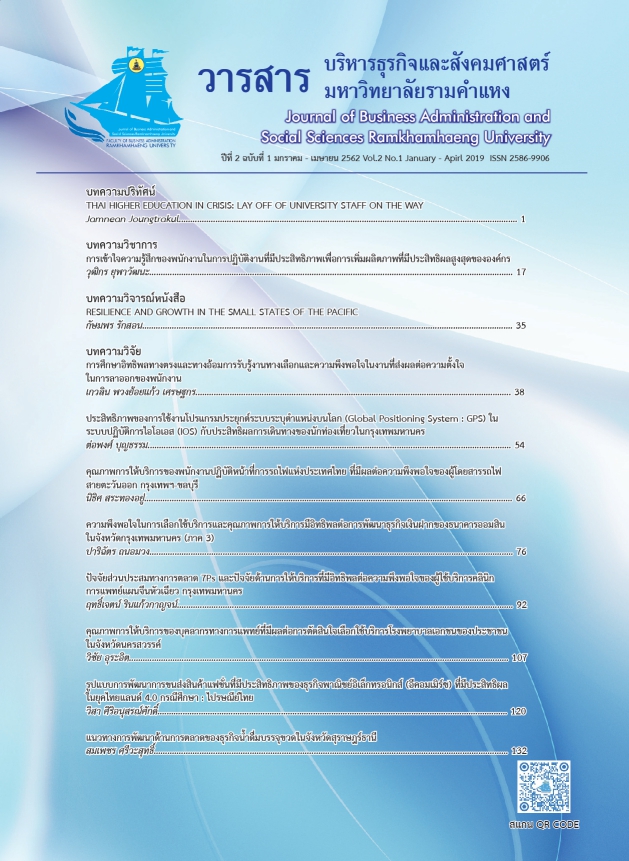THE STUDY OF DIRECT AND INDIRECT EFFECTS OF PERCEIVED JOB ALTERNATIVES AND JOB SATISFACTION ON TURNOVER INTENTION
Main Article Content
Abstract
The objectives of this research were to examine the direct and indirect relationship and a causal model of perceived job alternatives and job satisfaction on employees’ turnover intention. A total of 362 top Fast-Moving Consumer Goods (FMCG) company employees in Thailand were sampled. Questionnaires based on previous research were used in the study to collect the data. The data were analyzed using structural equation modeling with an exploratory factor analysis to confirm the path diagram through the usage of the SPSS and AMOS statistical programs. The results provided additional evidence in support of existing literature. Job satisfaction had a negative direct effect on turnover intention. Perceived job alternatives had a positive indirect effect on turnover intention through job satisfaction in the form of a partial mediator.
Article Details
เนื้อหาและข้อมูลในบทความที่ลงตีพิมพ์ในวารสารบริหารธุรกิจและสังคมศาสตร์ มหาวิทยาลัยรามคำแหง ถือเป็นข้อคิดเห็นและความรับผิดชอบของผู้เขียนบทความโดยตรง ซึ่งกองบรรณาธิการไม่จำเป็นต้องเห็นด้วย หรือร่วมรับผิดชอบใดๆ
บทความ ข้อมูล เนื้อหา รูปภาพ ฯลฯ ที่ได้รับการตีพิมพ์ในวารสารบริหารธุรกิจและสังคมศาสตร์ มหาวิทยาลัยรามคำแหง ถือเป็นลิขสิทธิ์ของวารสารบริหารธุรกิจและสังคมศาสตร์ มหาวิทยาลัยรามคำแหง หากบุคคลหรือหน่วยงานใดต้องการนำบทความทั้งหมดหรือส่วนหนึ่งส่วนใดไปเผยแพร่ต่อ หรือเพื่อกระทำการใดๆ จะต้องได้รับอนุญาตเป็นลายลักษณ์อักษรจากวารสารบริหารธุรกิจและสังคมศาสตร์ มหาวิทยาลัยรามคำแหง ก่อนเท่านั้น
References
สลักจิต ตันติบุญทวีวัฒน์ และคัคนางค์ มณีศรี. (2556). อิทธิพลของความเป็นส่วนหนึ่งในงาน ความพึงพอใจในงานและความผูกพันกับองค์การ ต่อความตั้งใจในการลาออก. วารสารวิชาการ Veridian E-Journal, 6(3), 699-717.
Arnold, H. J., & Feldman, D. C. (1982). A multivariate analysis of the determinants of job turnover. Journal of Applied Psychology. 67(3), 350-360.
Chew, H. G., Ng, K. Y. N., & Fan, S. W. (2016). Effects of alternative opportunities and compensation on turnover intention of Singapore PMET. International Journal of Humanities and Social Sciences, 10(3), 720-728.
Crossley, C. D., Bennett, R. J., Jex, S. M., & Burnfield, J. L. (2007). Development of a global measure of job embeddedness and integration into a traditional model of voluntary turnover. Journal of Applied Psychology, 92(4), 1031-1042.
Darrat, M. A., Burton, D. A., & Bennett, R. J. (2017). Examining the impact of job embeddedness on salesperson deviance: The moderating role of job satisfaction. Industrial Marketing Management, 22(63), 158-166.
Griffeth, R. W., & Hom, P. W. (1988). A comparison of different conceptualizations of perceived alternatives in turnover research. Journal of Organizational Behavior, 9(2), 103-111.
Holtom, B. C., Mitchell, T. R., Lee, T. W., & Eberly, M. B. (2008). Turnover and retention research: A glance at the past, a closer review of the present, and a venture into the future. The Academy of Management Annals, 2(1), 231-274.
Hom, P. W., Mitchell, T. R., Lee, T. W., & Griffeth, R. W. (2012). Reviewing employee turnover: Focusing on proximal withdrawal states and an expanded criterion. Psychological Bulletin, 138(5), 831-858.
Hom, P.W., & Griffeth, R.W. (1995). Employee Turnover. Cincinnati, OH: South-Western College Publishing.
Hulin, C. L., Roznowski, M., & Hachiya, D. (1985). Alternative opportunities and withdrawal decisions: Empirical and theoretical discrepancies and an integration. Psychological Bulletin, 97(2), 233-250.
Issa, D. M., Ahmad, F., & Gelaidan, H. M. (2013). Job satisfaction and turnover intention based on sales person standpoint. Middle-east Journal of Scientific Research, 14(4), 525-531.
Lambert, E. G., Hogan, N. L., & Barton, S. M. (2001). The impact of job satisfaction on turnover intent: a test of a structural measurement model using a national sample of workers. The Social Science Journal, 38(2), 233-250.
Luthans, F. (2008). Organizational Behavior (11th ed.). New York: McGraw-hill.
Mitchell, T. R., Holtom, B. C., Lee, T. W., Sablynski, C. J., & Erez, M. (2001). Why people stay: Using job embeddedness to predict voluntary turnover. The Academy of Management Journal, 44(6), 1102-1121.
Mobley, W. H. (1977). Intermediate linkages in the relationship between job satisfaction and employee turnover. Journal of Applied Psychology, 62(2), 237-240.
Morrell K. M., Loan-Clarke J., & Wilkinson A. J. (2001). Unweaving Leaving: the use of models in the management of employee turnover. International Journal of Management Reviews, 3(3), 219-244.
Mowday, R. T., Porter, L. W., & Steers, R. M. (1982). Employee-Organization Linkages The Psychology of Cornmitment, Absenteeisrn and Turnover. New York: Academic Press.
Mano-Negrin, R., & Tzafrir, S. S. (2004). Job search modes and turnover. Career development international, 9(5), 442-458.
Price, J. L. (2001). Reflections on the determinants of voluntary turnover. International Journal of manpower, 22(7), 600-624.
Rabbi, F., Kimiya, F., & Farrukh., M. (2015). The impact of job satisfaction, perceived availability of job alternative on turnover intention. Journal for studies in management and planning, 1(11), 319-328.
Ramesh, A., & Gelfand, M. J. (2010). Will they stay or will they go? The role of job embeddedness in predicting turnover in individualistic and collectivistic cultures. Journal of Applied Psychology, 95(5), 807-823.
Samad, S. (2006). The contribution of demographic variables; Job characteristics and Job satisfaction on Turnover intentions. Journal of International Management Studies, 1(1), 1-12.
Smith, P. C., Kendall, L. M., & Hulin, C. L. (1969). The Measurement of Satisfaction in work and retirement. Chicago: Rand-McNally.
Spector, P. E. (2003). Industrial and organizational psychology: Research and practice (3rd ed.). New York: John Wiley and Sons, Inc.
Steel, R. P., & Griffeth, R. W. (1989). The elusive relationship between perceived employment opportunity and turnover behavior: A methodological or conceptual artefact? Journal of Applied Psychology, 74(6), 846-854.
Treuren, G. (2013). The relationship between perceived job alternatives, employee attitudes and leaving intention. ANZAM Conference 2013.
Vandenberg, R. J., & Nelson, J. B. (1999). Disaggregating the motives underlying turnover intentions: When do intentions predict turnover behavior? Human Relations, 52(10), 1313-1336.


